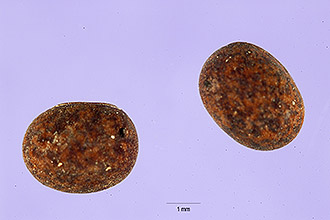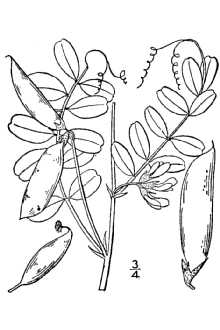Louisiana Vetch
Scientific Name: Vicia ludoviciana Nutt.

| General Information | |
|---|---|
| Usda Symbol | VILU |
| Group | Dicot |
| Life Cycle | Annual |
| Growth Habits | Forb/herbVine, |
| Native Locations | VILU |
Plant Guide
Uses
Livestock: Deer pea vetch (Vicia ludoviciana Nutt.) a cool season annual legume that is grazed by livestock. Wildlife: Deer pea vetch provides leaf material for wildlife forage. It also produces seeds which are eaten by bobwhite quail and Rio Grande Turkeys.
Status
Please consult the PLANTS Web site and your State Department of Natural Resources for this plant’s current status (e.g., threatened or endangered species, state noxious status, and wetland indicator values).
Description
General: Deer pea vetch is a cool season, annual legume that has climbing stems. Leaves are 3-9 cm long with 6 to 12 leaflets rachis terminating in a usually forked tendril. Flowers are generally solitary, and are lavender-blue in color. Pods are 2-3 cm. long, with 4 to 8 seeds in each pod. Seed is spherical in shape very hard and light brown in color with dark brown markings (Correll and Johnston, 1970). Distribution: The natural range of deer pea vetch is throughout the southern half of the United States. For current distribution, please consult the Plant Profile page for this species on the PLANTS Web site.
Adaptation
Deer pea vetch grows best on medium to heavy textured soils.
Establishment
Seedbed preparation should begin well in advance of planting. Planting should be done in late fall to early winter in South Texas. Deer pea vetch can also be included in warm-season planting mixtures, but will not establish until the fall after planting. Establish a clean, weed-free seedbed by either tillage or herbicides. Prior to planting, the site should be firm and have accumulated soil moisture. Deer pea vetch can be seeded using a drill or broadcaster. If broadcast seeded, some type of additional coverage such as culti-packing or light dragging is recommended to ensure good seed to soil contact. Seed should be planted 1/8 to 1/4 inch deep. It is better to plant too shallow than too deep. If one plant per square foot has become established in field plantings, then the seeding can be considered successful.
Management
Areas planted to Hoverson Germplasm should be deferred for 30 days to allow plants to become established, Established plants should be allowed to produce seed annually because in many areas with proper soil moisture deer pea vetch readily reseeds itself with minimal soil disturbance, Use soil moisture sensors to measure the soil moisture of Louisiana Vetch., As perennial cover increase on most sites deer pea vetch decreases without soil disturbance,
Pests and Potential Problems
No severe insect or disease problems have been observed in deer pea vetch once established.
Environmental Concerns
Concerns
Concerns
There are no known environmental concerns associated with deer pea vetch.
Seeds and Plant Production
Plant Production
Plant Production
Seed increase plots have been managed by flat drill planting on 8” rows. It can also be grown from transplants planted in the late fall. Harvesting when 50% of the seed is ripe allows for some seed to
References
shatter allowing stand to reseed itself for subsequent Correll, D. S., and M. C. Johnston. 1970. Manual of years of harvest. the vascular plants of Texas. Texas Research Foundation, Renner, TX. Seed can be harvested using a combine with a grain Everitt, H.J., D.L. Drawe, and R.L. Lonard. 1999. header. This harvest method will result in both green Field Guide to the Broad-Leaved Herbaceous and mature seed, as well as other high moisture Plants of South Texas. Texas Tech University material in the harvested product. Most of the green Press, Pg. 145. seed will mature, but care must be taken to insure Smith, F.S., A.D. Falk, and W.R. Ocumpaugh. 2012. adequate seed drying procedures are followed to Notice of Release of Hoverson Germplasm deer prevent molding and heating of this mixture. Seed pea vetch. Caesar Kleberg Wildlife Research harvested with this method is best cleaned by Institute. Kingsville, TX. hammer milling to release seed from un-opened pods, then screened using a Clipper seed cleaner. Prepared By: John Lloyd-Reilley, Manager USDA-NRCS, E. “Kika” de la Garza Plant Materials Cultivars, Improved, and Selected Materials (and Center, Kingsville, Texas area of origin) Hoverson Germplasm deer pea vetch was released by Forrest S. Smith, Director South Texas Natives, the E. “Kika” de la Garza Plant South Texas Natives, Caesar Kleberg

